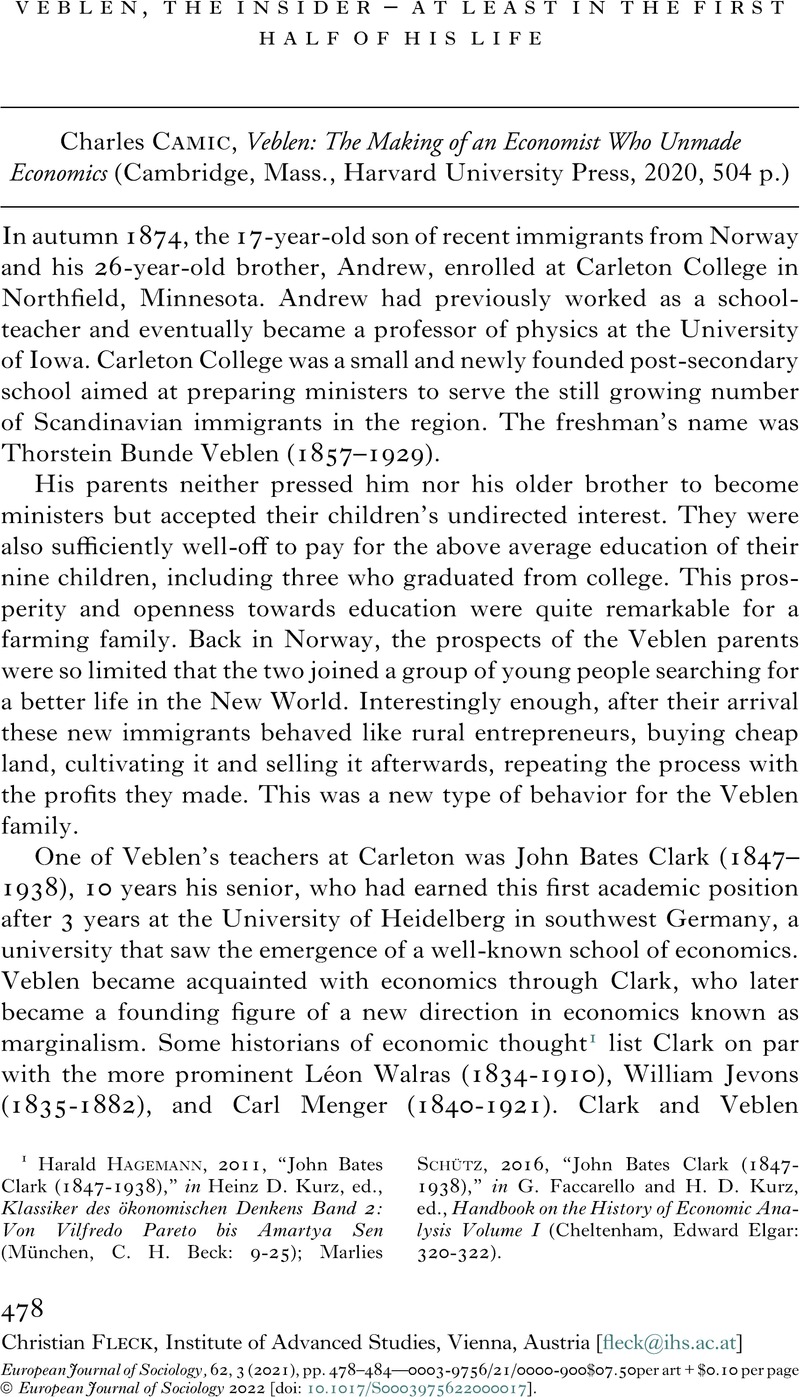No CrossRef data available.
Published online by Cambridge University Press: 05 May 2022

1 Harald Hagemann, 2011, “John Bates Clark (1847-1938),” in Heinz D. Kurz, ed., Klassiker des ökonomischen Denkens Band 2: Von Vilfredo Pareto bis Amartya Sen (München, C. H. Beck: 9-25); Marlies Schütz, 2016, “John Bates Clark (1847-1938),” in G. Faccarello and H. D. Kurz, ed., Handbook on the History of Economic Analysis Volume I (Cheltenham, Edward Elgar: 320-322).
2 Lewis A. Coser claimed that Edward Bellamy had a strong impact on Veblen’s thinking [Pages 289-290, in Lewis A. Coser, (1971) 1977, Masters of Sociological Thought: Ideas in Historical and Social Context (New York, Harcourt Brace Jovanovich)]; Camic rejects this interpretation, although it does so on the basis of unsatisfactory arguments [221 and 317].
3 John Dos Passos, The 42nd Parallel (1930), 1919 (1932), and The Big Money (1936), published together in one volume titled USA by Modern Library in 1937.
4 HUP’s website: https://www.hup.harvard.edu/catalog.php?isbn=9780674659728.
5 Two papers ignored by Camic may be sufficient to support my criticism: Robert Dimand, 1998, “Fisher and Veblen: Two Paths for American Economics,” Journal of the History of Economic Thought, 20 (4): 449-465; and Cohen, Avi J., 2014, “Veblen Contra Clark and Fisher: Veblen-Robinson-Harcourt lineages in capital controversies and beyond,” Cambridge Journal of Economics, 38 (6): 1493–1515.CrossRefGoogle Scholar
6 Camic’s reconstruction of the trajectory of this concept is much more persuasive than his application in Veblen: Charles Camic, 2011, “Repetition with Variation: A Mertonian Inquiry into a Lost Mertonian Concept,” in Y. Elkana, A. Szigeti and G. Lissauer, eds, Concepts and the Social Order: Robert K. Merton and the Future of Sociology (Budapest, Central European University Press: 165-188).
7 Veblen is prominently portraited in Arthur K. Davis’s article [1968], Coser,’s one [(1971) 1977] and Dorothy Ross’s book [1991], but ignored in Pitirim Sorokin’s [1928], Neil J. Smelser and Paul B. Baltes’ [2001], Stephen P. Turner [2014], ones and sidelined in Craig Calhoun’ book, [2007]. Cf. Arthur K. Davis, 1968, “Veblen, Thorstein,” in D. L. Sills, ed., International Encyclopedia of the Social Sciences, (New York, MacMillan: 303-308); Coser, (1971) 1977 [cf. infra note 2: 263-302]; Dorothy Ross, 1991, The Origins of American Social Science (Cambridge, Cambridge University Press); Pitirim Sorokin, 1928, Contemporary Sociological Theories (New York, Harper & Row); Neil J. Smelser and Paul B. Baltes, eds, 2001, International Encyclopedia of the Social & Behavioral Sciences (Amsterdam, Elsevier); Stephen P. Turner, 2014, American Sociology: From Pre-Disciplinary to Post-Normal (Basingstoke, Palgrave Pivot); Craig Calhoun, ed., 2007, Sociology in America: A History (Chicago, University of Chicago Press).
8 The “International Thorstein Veblen Association”, founded in 1994, seems to have stopped its activities after the death of its founder Arthur J. Vidich in 2006.